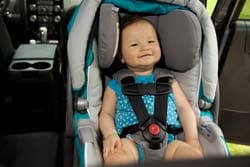In the United States, motor vehicle crashes are a leading cause of death among children. In 2017, 675 children 12 years old and younger died in motor vehicle crashes, and nearly 116,000 were injured. Of the children 12 years old and younger who died in a crash in 2017 (for which restraint use was known), 35% were not buckled up. Parents and caregivers can make a lifesaving difference.
Whenever you’re on the road, make sure children—aged 12 and under—are buckled in age- and size-appropriate car seats, booster seats, or seat belts, and always in the back seat.
Data shows that:
- In 2017, restraint use saved the lives of 325 children ages 4 years and younger.
- Car seat use reduces the risk for injury in crashes by 71–82% for children, when compared with seat belt use alone.
- Booster seat use reduces the risk for serious injury by 45% for children aged 4-8, when compared with seat belt use alone.
As part of National Child Passenger Safety Week, National Seat Check Saturday will take place on September 21st, where drivers with child passengers are encouraged to visit a child safety seat inspection station to have a certified technician inspect their car seat and to give hands-on advice and assistance free of charge. Locate a car seat inspection stationexternal iconexternal icon in your area.
Make sure children are properly buckled in a car seat, booster seat, or seat belt-whichever is appropriate for their weight, height, and age.
- Use a rear-facing car seat from birth until ages 2–4.
- For the best possible protection, infants and toddlers should be buckled in a rear-facing car seat, in the back seat, until they reach the maximum weight and height limits of their car seat.
- Check the seat owner’s manual and/or labels on the seat for weight and height limits.
- After outgrowing the rear-facing car seat, use a forward-facing car seat until at least age 5.
- When children outgrow their rear-facing seats, they should be buckled in a forward-facing car seat, in the back seat, until they reach the upper weight or height limit of their car seat.
- Check the seat owner’s manual and/or labels on the seat for weight and height limits.
- After outgrowing the forward-facing car seat, use a booster seat until seat belts fit properly.
- Once children outgrow their forward-facing seat, they should be buckled in a belt positioning booster seat, in the back seat, until seat belts fit properly. Seat belts fit properly when the lap belt lays across the upper thighs (not the stomach) and the shoulder belt lays across the chest (not the neck).
- Once seat belts fit properly without a booster seat, use a seat belt on every trip.
- Children no longer need to use a booster seat once seat belts fit them properly. Seat belts fit properly when the lap belt lays across the upper thighs (not the stomach) and the shoulder belt lays across the chest (not the neck).
- Proper seat belt fit usually occurs when children are about 4 feet 9 inches tall and ages 9–12 years. Seat belt fit can vary by vehicle so check fit in all vehicles. For the best possible protection, keep children properly buckled in the back seat.

Make sure children are always properly buckled in the back seat in a car seat, booster seat, or seat belt, whichever is appropriate for their weight, height, and age.
Install and use car seats and booster seats according to the seat owner’s manual. You can get help installing them from a certified child passenger safety technician. Find a child passenger safety technician.
Buckle all children aged 12 and under in the back seat.
- Buckle children in the middle of the back seat when possible, because it is the safest spot in the vehicle.
- Airbags can kill young children riding in the front seat. Never place a rear-facing car seat in front of an airbag.
- Buckle children in car seats, booster seats, or seat belts on every trip, no matter how short.
- Set a good example and help protect everyone in the car by always using your seat belt.
Source: US Department of Health & Human Services, “Child Passenger Safety.” cdc.gov website. Accessed September 1, 2020. http://www.iii.org/individuals/auto/lifesaving/airbags/
© Copyright 2020. All rights reserved. This content is strictly for informational purposes and although experts have prepared it, the reader should not substitute this information for professional insurance advice. If you have any questions, please consult your insurance professional before acting on any information presented. Read more.


